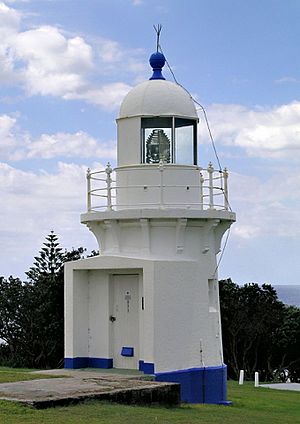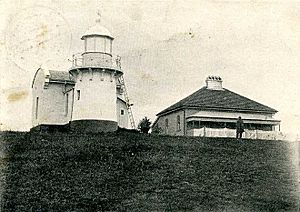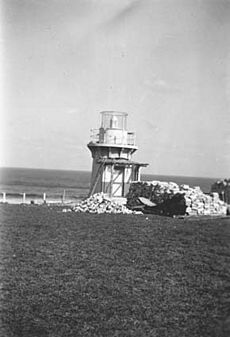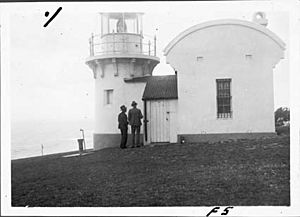Richmond River Light facts for kids
 |
|
| Richmond River Light, 2006 | |
|
|
|
| Location | Ballina New South Wales Australia |
|---|---|
| Coordinates | 28°52′1.31″S 153°35′30.49″E / 28.8670306°S 153.5918028°E |
| Year first constructed | 1866 |
| Year first lit | 1880 |
| Automated | 1920 |
| Construction | stone tower |
| Tower shape | cylindrical tower with balcony and lantern |
| Markings / pattern | white tower and lantern |
| Height | 25 feet (7.6 m) |
| Focal height | 115 feet (35 m) |
| Original lens | 4th order catadioptric |
| Current lens | 2nd order Chance Brothers Fresnel lens |
| Intensity | 28,000 cd |
| Range | 14 nautical miles (26 km; 16 mi) |
| Characteristic | Fl (4) W 16s. |
| Admiralty number | K2834 |
| NGA number | 111-5888 |
| ARLHS number | AUS-142 |
The Richmond River Light is an important lighthouse in Ballina, Australia. It is also known as the Ballina Head Light or Ballina Light. This lighthouse stands on Ballina Head, a piece of land that sticks out into the sea.
It is located at the northern side of the entrance to the Richmond River. Lighthouses help guide ships safely into ports. The Richmond River Light also works with another smaller light to guide ships into the river. This smaller light is a ship's masthead lantern, raised on a wooden structure 30 meters away.
Contents
History of the Richmond River Light
The first light at this spot was set up in 1866. It was a temporary light, meaning it wasn't meant to be permanent. The plans for this light were made by a famous architect named James Barnet. At the same time, another light was installed at the Clarence River.
The lighthouse you see today was built later. It is one of five lighthouses designed by James Barnet between 1878 and 1880. The other four lighthouses are Fingal Head Light, Clarence River Light (which is no longer there), Tacking Point Lighthouse, and Crowdy Head Light.
Work on the Richmond River Light began in 1879. It was finished and first lit in 1880.
When it first started, the light used a special lens called a 4th order catadioptric apparatus. This type of lens uses both reflection and refraction to make the light brighter. It was not very strong, less than 1000 cd, and could be seen for about 12 nautical miles.
The light was powered by colza oil. Because there was a nearby pilot station (where river pilots helped guide ships), only one light keeper was needed to operate the lighthouse.
In 1920, the lighthouse was updated. It was changed to use acetylene gas and became automated. This meant it could run by itself without a keeper always being there. In November 1940, a small attached room and porch were removed from the lighthouse.
The light was updated again in the 1960s to use electricity. Today, the light is very bright, 28,000 cd. It uses a 1,000 Watt tungsten-halogen lamp. It gets its power from the main electricity supply, with a battery backup in case the power goes out.
The light has a special pattern to help ships identify it. It flashes four times in a row, and then there is a pause. This whole pattern repeats every 16 seconds.
How the Lighthouse is Built
The Richmond River Light tower looks very similar to the other four lighthouses designed by James Barnet. It is round, with an inside diameter of about 6 feet. The walls are thick at the bottom and get a bit thinner towards the top.
The tower is made of stone and covered with a smooth cement layer, painted white. At the top of the tower, there is a platform made of bluestone. This platform is supported by twelve stone brackets called corbels. It is about 12 feet above the ground.
You can reach the platform by an iron staircase inside the tower. Around the edge of the platform, there is a metal handrail to keep people safe. On top of the platform is a simple metal dome that holds the light and lens.
Originally, the lighthouse had a porch and a rectangular room called an annexe. This annexe was used as a duty room and to store oil. Both of these parts were removed in November 1940. There is still a one-story house on the property where the lighthouse keeper used to live.
Who Manages the Lighthouse
The light itself is currently managed by Roads and Maritime Services. This is a government agency that looks after roads and waterways. The land where the lighthouse stands is managed by the New South Wales Department of Lands.
Visiting the Lighthouse
You can visit the area around the lighthouse. It is open to the public, and you can walk around the site. However, the lighthouse tower itself is usually closed, so you cannot go inside.





